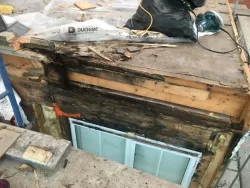Is your strata, multi-family housing, apartment, condominium or townhome community starting the building remediation process? From a landscaper’s perspective, there are some key factors that must be checked off before your restoration project begins.
We’ve put together a 6 step checklist for you to follow which we use every time we complete a client’s building remediation process.
Why is Building Remediation so Common in the Greater Vancouver Region?
During the 1980’s and 1990’s, poor building practices led to tens of thousands of condominium residents experiencing water ingress into their units. This resulted in numerous buildings needing envelope repairs. Most of these situations have been long since dealt with; however, if your building is over 25 years old, you likely have already or will be budgeting for membrane repairs.
Step 1: Identifiy the Problem
Water Ingress – This is one of the common signs of a failed membrane. A professional landscape contractor can help identify the problem area by excavating planters or soil from above slab, removing pavers, slabs or hard surfacing, lifting decking, etc.

Example of damage caused by water ingress to building envelope.
Regular Inspections – After the life expectancy of the membrane is reached, typically 20-25 years, it is recommended regular inspections of the membrane take place. Your landscape contractor should work with Building Science Specialists by excavating to the membrane in designated areas for thorough examination and testing.
Step 2: Planning
Engineers & Building Science Specialists – Your landscape contractor should work with all consultants involved in every way possible to ensure the scope of work is clear and the identified areas are properly exposed and prepped.

Step 3: Drawings & Permits
Drawings and Design – Your landscape contractor should provide professional, computer aided plans and designs for the re-landscaping of the project. They should also be able work with any landscape architects or consultants if required by the city.
Arborist Reports and Removal Permits – When trees need removing from the landscape in order to complete the repairs, some municipalities will require documentation of the existing trees and proposed replacement plans. Your landscape contractor should have an ISA Certified Arborists that can help with this.
Step 4: Removal of Landscape
Plant Material – Your landscape contractor should prune plant material back off buildings to make room for scaffolding, remove and dispose of existing plant material on slab, and transplant plant material where possible.
Hardscapes – They should lift and relocate or dispose of paving stones or slabs, deconstruct arbors and fencing, pull apart planters and retaining wall systems, etc.
Soil and Rock – They should remove rock ballast from roof tops, excavate and store soil on site for minor repairs or dispose of soil in planters or on larger, more involved project sites.

Building exterior with softscape and hardscape elements removed in preparation for membrane repairs
Step 5: Membrane Repair
Roofing/Membrane Experts – Your landscape contractor should work with these trades to ensure the preparation is done correctly and the drainage root barrier and membrane protection are done properly.

Step 6: Re-Landscaping
Design – Your landscape contractor should provide professional computer aided drawings and designs for the new landscape using appropriate plants and materials for the application.
Installation – Finally, your landscape contractor will provide full landscape installation services to restore the damaged areas back to new. They will also work with other designers or landscape architects if required to ensure their vision for the landscape is achieved.

Have you hit all the components in our checklist?
Once the extent of the repair is determined by an engineering service, any above slab or rooftop landscape that is in the area will need to be removed all the way down to the membrane layer, thereby readying it for the roofing company to remediate.
Depending on the extent, most municipalities will require permits for the repair. They will often request a landscape plan of what is currently existing and landscape plans of what will be reinstalled.
It’s important to hire a professional landscape company that can assist with your restoration project from drawings, plant and soil removals, all the way to reinstalling with the updated plan.

It can be a headache to go through all the different steps because of the coordination involved between stakeholders. If you’re located in an area we service, please reach out if you want advice or support along the way during your building’s remediation journey.

Comments are closed here.